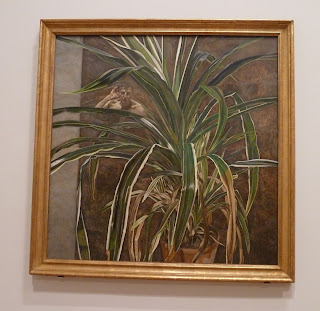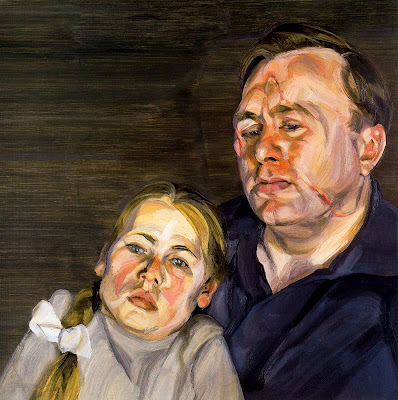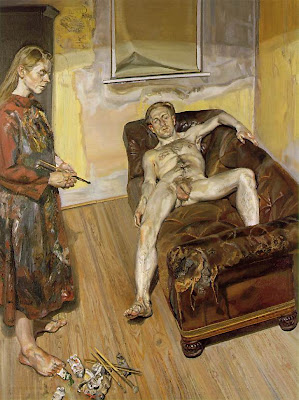Francis Bacon
He effortlessly
captures the great man’s potent mix of coyness and danger with a deft and
economic use of line. In a pose staged by Bacon himself, with the open trouser
and hands on hips presenting him as both coquettish and Machiavellian, Freud
presents to us a practised seducer, luring the viewer into a world of
surprising tenderness with an underlying threat of violence. The pencil
portrait of his friend is executed on white paper with two conté crayon sketches on either side.
These are black and white works on Ingres paper from ’46 & 48 respectively.
In these the hard square lines of compressed graphite and wax enmesh themselves
into the chain and laid line surface. The effect is a softening one in which a
radiant and glittering white surface is kissed with graphite details, like
metallic etchings revealing fine hair and more detail but not quite containing
the substance and hard reality of the Bacon. It is a great pity his unfinished
oil painting of the great man is not here, reminiscent of a cross between
Timothy Spall in Mike Leigh’s “Secrets & Lies” and Harry Redknapp, the
earthy painting is a fantastic study, painted with huge empathy.
In the same room
as the Bacon are three paintings of his first wife Kitty.
Almost
Illustrative, in the best and most beautiful sense, very green, flat and with Kitty
sharing the same expression, what is most striking about them is how very
different they are from the later works. Like Magritte without the surrealism, or Miro
without the abstraction, they contain a huge amount of information below the
flawless flatness of their immaculately worked surface. It is not the last time
in this exhibition that I can sense something Hitchcock like and stylized in
the composition and style. Much has been written to align this period of
Freud’s work with early Netherlandish painting such as the work of Jan Van
Eyck, (he of the Arnolfini Portrait) and while the hyper detailed sable brush
work can be seen to have been applied with the same painstaking patience, the
huge eyes and stylized outlines hint at
something else. The war may have ended but the art world was still deep in the
eye of a storm. Abstract art had given birth to action painting and had thrown
the post war canvas on to the floor for artists to violently flick, dribble and
hurl there pigment at it. Freud’s friend and contemporary Francis Bacon had
rendered his own shocking and violent, existentialist whirlwind in his Three Studies For Figures at the Base of a
Crucifixion, three years earlier. Yet here was Freud painting like Dali
without the sur prefix, his own realism almost old fashioned and art nouveau
like, the hard outlines of this poster work crisply delineated but with each
hair and detail perfectly realised.
Girl with a kitten
Oil
on Canvas, 1947
Girl in a dark jacket
Oil
on Panel, 1947
Girl with roses
Oil
on Canvas, 1947-8
Sleeping Nude
Oil
on Canvas, 1950
I am
already shedding my preconceptions and am struck by the lack of blue. In
reality I thought the acres of flesh would haunt me, skewing my chromatic
calibration and drowning me in deep fathoms of sallow blueness. Maybe it is the
years exposed to the habitual colour lies of computer monitors, or the
generational nature of Televisions unfaithful reproduction, producing a
facsimile of diminishing accuracy, like the texture free print and its inability
to reproduce the reality of a great painting. Curiously I return from the
exhibition unable to locate the source of this blue preoccupation or any
evidence of it in any format. It is as though the power of witnessing the
original work has somehow irrevocably established a new treatise between viewer
and artist.
Great
horizontal light throws a much more sympathetic green light on the model, modestly
voluptuous, and luxuriant, both fabric and skin are allocated a depth and
sumptuousness that makes your thumbs itch. It is only two years since the
feline and flat Girl with roses but already it seems a lifetime away, nearly
another artist and yet here it is in the same room, demonstrating a marked move
towards something deeper.
Interior with plant, reflection listening
(Self-Portrait)
Oil
on Canvas, 1967-8
Freud
top left peering out without the benefit of eyes, only shadow where they
normally reside. I cannot help but imagine a 360 degree sound field, and can not
decide if interpreting it would place him in the front or rear left speaker. The
perspective is not uniform and the whole composition is wrong headed. A nod to
the secret life of plants? Surely this can not be an example of Jungian
symbolism or Freudian psycho babble? It
seems like an aberration, a curiosity or drug induced audible hallucination in
a straight man’s world.
Reflection with two children
(Self-Portrait)
Looking
down into a mirror on the floor, the painter gathers his jacket with a claw
like hand. The hand has a tortured spasticity as though the tendons are shrunk
by some neurological calamity. It is a view that encourages dislocation, the
painter looming and looking with contempt and disdain, his one claw like hand
grasping his jacket with a weird scale that show’s little deference to his
small children below. The perspective and cinematic nature once again reminds
me of Hitchcock. It is very much a product of it’s time. He is like an actor
with his place in the frame echoing the same aesthetic of films from the time. Freud
is Michael Cain as Harry Palmer, or Jack Carter, all London chic and brooding machismo.
Frank Auerbach
Oil
on Canvas, 1975-6
What
I originally thought was Freud turns out not to be. Surely this is a boxer or
physically engaged man?, the strength of
his bone structure revealing his massive forehead, almost weaving away
from incoming blows, his intensity, square and solid, but no it is the Painter
Frank Auerbach. The robust nature of his own work is mirrored in the solidity
and unmovable bulk of his great brass like and sculptural head, and yet he is
presented abridged, cramped into a narrow frame leaving you to imagine his
heaving shoulders, rolling like bowling balls beneath his grey t-shirt.
The Painter’s Father
His
apparent difficulty in capturing his father says much. Rather than being
concise and economic like the Bacon it seems unfinished. Each absent line
suggesting a misapprehension, or misunderstanding, of his Papa. The broad nose
and Hesseltine/Tarzan like receding floppy fringe reveals only the inherited
physicality and none of the emotional content. Perhaps all sons and fathers
suffer from this sense of unfinished business whatever the relationship.
I do
not go along with the assertion that Freud’s paintings of his mother are
Rembrandt like. I can glimpse little of her character in what seems like an
effort on the painter’s part to avoid darkness she seems over studied, posed
and photographic only in
The Painter’s Mother Resting
Oil
on Canvas, 1976
does both painter and sitters guard fall and glimpses of a connection reveal themselves. The soft cotton woolly bed cover and silky paisley nightdress hints at the uncomfortable familiarity they shared.
A man and his daughter
Oil
on Canvas, 1963-4
The
scarred bank robber looks strangely at ease and flushed with colour, from the
crimson gash of his old wounds to the depth of his fallen brow and orange nose.
His daughter in contrast looks pale and yellow rigid with if not outright fear
at least a little apprehension. Her heavy square face betraying an awareness of
life’s brutality her father’s precarious profession has exposed her to. It is
as though somehow she has revulsion more of his betrayal than the scars his
colleagues have left on his face.
Boy Smoking
Small,
intense, and detailed, the young man's furrowed brow reveals a laconic attitude
that emerged along with the idea of being a teenager in the nineteen fifties.
There is a whiff of James Dean about his hair and pose but he looks like a
British barrel boy, comfortable smoking. For him it is neither a prop nor
studied affectation. Though apparently caught in the act of breaking into
Freud’s studio with his brother, there is not a hint of judgement in the artists
rendering of him, only empathy.
Hotel Bedroom
Oil
on Canvas, 1954
Freud
looks elfin like and small in the background. There is an amazing and
fastidious facilitation of his fine sable brush in rendering the detail in the
texture of the fabric he is wearing. The light is on his wife and he looks like
a Gaiman/Sandman character, from another god like dimension while his pale
glowing wife nibbles her finger, lost in thought on how two people in one room
can be so far apart as though in different worlds.
Painter and Model
Not shying away from having his cock, balls and ass hole occupying the apex of the picture, Freud tries to look uninterested as if he is the passive model in his painter wife’s portrait. She plays along not engaging the viewer in eye contact, and while her face is bright in contrast with her paint sodden smock, it is Lucien who dominates this composition. He does not exaggerate his boyish arms. From here on in the scale of both paintings and subjects gets ramped up. It begins with
Two Men in the Studio
Oil
on Canvas, 1986-7
Not shying away from having his cock, balls and ass hole occupying the apex of the picture, Freud tries to look uninterested as if he is the passive model in his painter wife’s portrait. She plays along not engaging the viewer in eye contact, and while her face is bright in contrast with her paint sodden smock, it is Lucien who dominates this composition. He does not exaggerate his boyish arms. From here on in the scale of both paintings and subjects gets ramped up. It begins with
Two Men in the Studio
Oil
on Canvas, 1987-9
Is
it Cerith Wyn Evans who dominates this picture? Like a pale Welsh Giant
crushing Angus Cook? His feet are huge like hooves and I do not recognise him
without his waxed moustache. Much is made of the crumpled material painted in
the studio background and whilst the technical accomplishment is no doubt well
executed it is the figures that dominate. Freud was a great painter of people.
Not adequate or good, great. His portraits of Leigh Bowery are huge, monumental
works that fill my minds ear with cellos intoning themes from Beethoven and
Wagner.
Lee Bowery Seated
Sue Tilley
Room
Big
Sue the Benefits Supervisor
Curiously
the big one made little impact until I sat down and viewed it at eye level.
Almost as though one had to join her in recline to fully empathise. At this
juncture and maybe simply because of scale, texture becomes a more obvious
ingredient. Like drying porridge the rendered goose bumps and flecks of
whirling cellulite add a hyper real dimensionality to these gargantuan grand
canvases. Predictably
Benefits Supervisor Sleeping
draws
huge numbers, but unlike many other works in the exhibition, people’s attention
is rather briefer than the model’s ample Titan like proportions. They gaze and
then look really closely, as if hoping that close examination will reveal a
hidden layer of Gold or map showing the location of Bullion and then they are
gone. It is a fine painting but perhaps they are right in adjudging it as not
his best. To my untrained eyes it is not
even the best in the room. The two other Tilleys, hung on the opposite wall are
more expressive.
Benefits Supervisor Resting
sees
Tilley on the other end of the sofa, head thrown back with the black screen
that recurs in many of his works behind her. The sole of her right foot is
revealed, her left resting in the alcove of her ankle. She is lit by God and
seems to revel in her bodies inviting pose.
Sleeping by the Lion Carpet
Here
Tilley is sleeping on a chair or chaise longue with what looks like a tapestry
or painting of an African Savannah behind her. A lion and Lioness stalk a
Gazelle maybe ironically as the woman sleeps with in eyeshot of Freud and his
painterly hunger for the rendition of her flesh. His eye ravaging her as she
sleeps, Lucien the gazelle stalks her in the pursuit of another kind of capture.
Here is his brilliance, his unstoppable pursuit. The fact that many paintings
span two years reveals his unrelenting hunger for the hunt. While Lenkiewicz
and other modern masters reveal their own voracious sexual desire in their
works, Freud seems to focus in revealing his subjects desires, fears and
actuality. While obviously no monk, Lucien was clearly in love with both his medium
(overwhelmingly Oil on Canvas) and the unabashed non prettifying documentation
of portraiture. His towering technical prowess, whilst never failing to
illuminate the detail, the light and the darkness, the broad wash of colour and
the minutiae of every drape, crease and layer of texture never gets in the way
of capturing the essence of the model. He utilises perspective (the screen)
colour and composition but only in service of the person inside the model. It
is this element that takes you out of the Gallery and through the paintings,
not only into the lofts and studios of Freud, or indeed merely into the lives
of the sitters. By being so focused and relentless, one is gifted a glimpse
into the mind of a true great, a modern master.
Ria,Naked Portrait
The
porridge effect is most pronounced here in the head of the girl, in fact all
over this canvas. Pushed to the back and top one senses tenderness, a painting
he wanted so much to get right. I thought that maybe this was because she was a
relative but it turns out it was probably more to do with his advancing age and
determination to do his best work
Self-Portrait, Reflection
Seeming
not to recognise himself Lucien looks old and frail almost as though he needs
the distance of a mirrored reflection to face his aged self. The arms length
perspective measuring of extending an arm and capturing the proportions of a
model have been replaced with an assessment of his own features only bearable
at a distance and through the bent
refraction of a mirrors inverted image.
I am
beginning to see why in 1997 the excellent Waldemar Januszczak asked, Is painting dead? The infamous Turner
prize television debate, in which Tracey Emin left to be with her mother,
outraged at the suggestion that such a thing could be seriously considered. To
learn to paint requires time and dedication, to become proficient and expressive
takes longer still. To develop and master a personal style with which to voice
such expressiveness will drain yet more grains of sand from one’s own personal
hourglass and that is before any consideration is given to art, the works and
artists who have gone before, and navigating this conversation, to establish a
place in paintings long and distinguished history. The task is momentous, a
huge undertaking of almost unfathomable difficulty.
To
attempt it is worthy and commendable, to touch it’s unmatchable directness must
be magical, but to throw your soul into the fire and fight long and hard,
through every waking hour, day and night, well and sick, ecstatic and dejected,
to rein it in and master it, that can only be said of a select few. When it
comes to portrait painting Lucien Freud was certainly one of those few and
possibly in modern times, the greatest.






















What do I say about your posts? I love them. I read them everyday and always wait for new ones. I am very happy because I have something interesting to read. Hope you can upload more and more.
ReplyDeleteSanta Snake wonderful games for free || seri games Adam And Eve 5 Part 1 || jogos free games Icy Purple Head
It is a great website.. The Design looks very good.. Keep working like that!. Biografia de Sigmund Freud
ReplyDelete